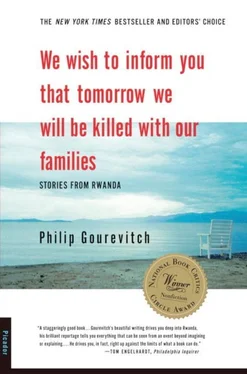Of course, there was no peace and no prospect of it, and by the middle of 1996, Kagame started assembling a seed force to mount a rebellion in Zaire. Zairean Tutsis, faced with the immediate threat of elimination, were ripe for recruitment, and they offered the added convenience of appearing and speaking enough like Rwandans so that if RPA soldiers mingled with them it would be difficult to tell them apart. But soldiers and political cadres were sought from throughout Zaire, and Kigali soon became the clandestine hub for all sorts of anti-Mobutists eager for armed struggle in Zaire.
After the destruction of the Tutsi communities of North Kivu, Kagame assumed that South Kivu would be the next target of the Mobutist–Hutu Power alliance, and he was not mistaken. About four hundred thousand Zairean Tutsis lived in South Kivu; they were known as the Banyamulenge—the people of Mulenge—because Mulenge was the place where their ancestors first settled after migrating from Rwanda in the seventeenth and eighteenth centuries. Since the establishment of the UN camps for Rwandan Hutus in 1994, the Banyamulenge had fallen prey to extensive cattle raids and to a mounting campaign of harassment and hostile propaganda. Before long Zairean officials were speaking openly of the Banyamulenge as “snakes” and taking measures to strip them of their land; local radio stations and newspapers sounded more and more like the Hutu Power media of Rwanda.
Programmatic violence against the Banyamulenge began in early September of 1996. Hutu Power and Mobutist forces, working together with locally recruited militias, sacked Tutsi homes, businesses, and churches and attacked their residents—arresting or executing some and expelling others to Rwanda. When Banyamulenge were lynched in the streets, government officials expressed approval. Although the UN and humanitarian agencies had teams throughout the area, there was no international outcry. But unlike the Tutsis of North Kivu, who went to their deaths and into exile without resistance, many Banyamulenge were armed and they fought back when attacked, inflicting substantial damage on their attackers. At the same time, hundreds of newly trained and well-equipped resistance fighters began to filter into Zaire from Rwanda. As the fighting intensified and spread, aid workers fled from much of South Kivu, abandoning those they had purported to protect to their own devices.
Then, on October 8, Lwasi Ngabo Lwabanji, deputy governor of South Kivu, proclaimed that all Banyamulenge residents of the province had one week to get out. He didn’t say where they should go, only that those who remained would be considered to be rebels in a state of war with Zaire. No doubt Lwasi was a bit overexcited; even in Zaire, deputy governors did not customarily declare war. But the spirit of his ultimatum was firmly in line with official Zairean attitudes and practices. Although Mobutu himself had just been diagnosed with prostate cancer and was undergoing treatment in Switzerland, he had been running Zaire as an absentee landlord for so long that his court continued to function as ever. Two days after Lwasi’s decree, a government spokesman in Kinshasa, the capital of Zaire, announced, “It’s true that we all want the Banyamulenge to leave.”
Kagame had been preparing for just such a moment. “We were ready to hit them,” he later told me, “hit them very hard—and handle three things: first to save the Banyamulenge and not let them die, empower them to fight, and even fight for them; then to dismantle the camps, return the refugees to Rwanda, and destroy the ex-FAR and militias; and, third, to change the situation in Zaire.” He was only waiting for the sort of massive provocation from Zaire that he presumed was inevitable. “And of course,” he said, “this stupid Zairean deputy governor gave us the opportunity.”
So tiny Rwanda hit enormous Zaire; the Banyamulenge rose up; RPA commandos and Laurent Kabila’s rebel seed force—the Alliance of Democratic Forces for the Liberation of Congo/Zaire (ADFL)—swept into South Kivu and began pushing north; Mobutu’s famously cowardly army fled ragtag; aid workers were evacuated, and the camps were dispersed. On November 2,1996, three and a half weeks after Deputy Governor Lwasi had declared civil war, the ADFL and the RPA marched into Goma, and Kabila proclaimed an area of at least a thousand square miles to be “liberated territory.” (While the Rwandan government was openly enthusiastic about these developments, it categorically denied that any RPA troops had entered Zaire until early June of 1997, several weeks after the ADFL forces took Kinshasa and drove Mobutu from power, at which point Kagame told me, “Everywhere it was our forces, our troops—they’ve been walking for the last eight months.”)
Thousands of Rwandans from the camps returned to Rwanda during the first weeks of fighting in Zaire, but by early November the great mass of them—at least three-quarters of a million people, from both North and South Kivu—were assembled on the vast lava field in and around the Mugunga camp, about ten miles west of Goma. They had been herded there by the ex-FAR and the interahamwe, by the pressure of the advancing Alliance, and even, incredibly, by some UNHCR officers, who had directed them away from Rwanda and toward Mugunga before themselves fleeing the country. After capturing Goma, Kabila declared a cease-fire, and called on the international humanitarian community to come and get the refugees out of his way so that he could continue his advance westward. Of course, Mugunga was completely inaccessible, behind a powerfully armed front line composed of tens of thousands of Hutu Power and Mobutist fighters. And that was precisely the point that Kabila and his Rwandan sponsors were trying to make: to get the refugees out of harm’s way, you had to be prepared to fight. What was needed was not a relief mission, but a rescue mission, because the noncombatants at Mugunga weren’t so much refugees as hostages, being held as a human shield.
It was another very strange time. During the first nine and a half months of 1996, the fact that the Mobutist–Hutu Power alliance in eastern Zaire was slaughtering thousands of people and forcing hundreds of thousands more from their homes did not seem to excite the international press. During that period, exactly one dispatch on the subject, reported from Rwanda, appeared in my local paper, The New York Times , and in its competition, The Washington Post, coverage had been limited to two freelance “opinion” pieces. Perhaps the idea that people called refugees not only suffer and require aid but also are capable of systematic crimes against humanity, and may require direct confrontation by military force, was considered too technical or confusing in an age of radically reduced foreign coverage. But, in early November, the prospect of three-quarters of a million refugees dying en masse, under siege or in battle on the lava fields, once more drew a pack of hundreds of reporters to the Rwanda-Zaire border. Goma was again the world’s leading international story—and nothing was happening.
Nobody could get to Mugunga, and nobody knew what condition the people gathered there were in. Relief agency press officers assured reporters that the refugees had to be suffering from mass starvation and cholera. Possible death tolls were invented and announced—tens of thousands of dead, perhaps a hundred thousand. It was terribly upsetting to be sitting at a lakefront hotel in the Rwandan border town of Gisenyi, surrounded by reporters, and to think that just a dozen miles to the west, out of sight and out of reach, people were dying the most preventable sorts of deaths at a record-breaking clip. And it made one feel even worse to wonder if maybe the situation over there wasn’t really so bad. If you asked the relief agency press officers when, in history, previously well-fed people had starved to death in a few weeks, you either got no answer or you were told that most of the people at Mugunga were women and children.
Читать дальше











